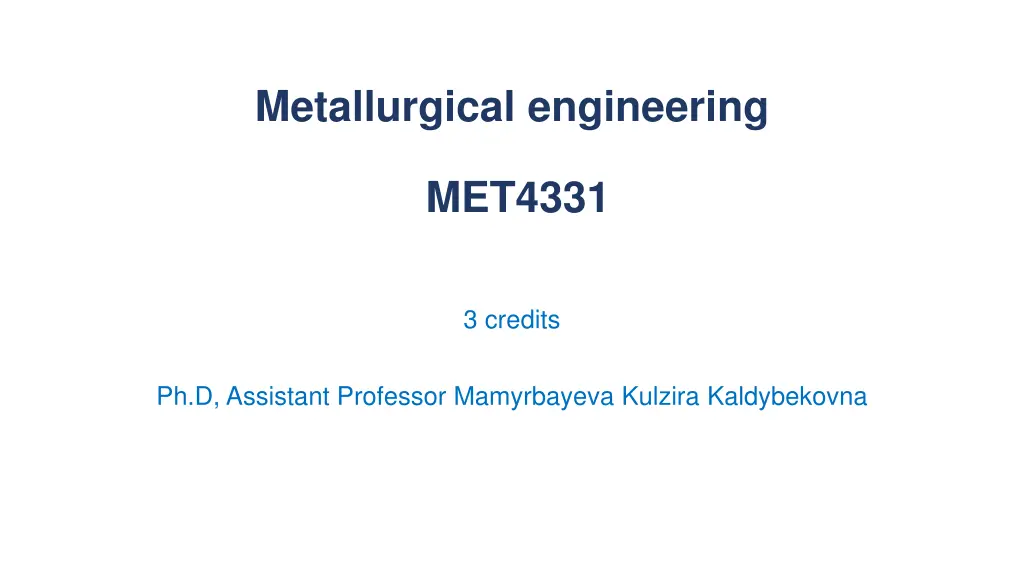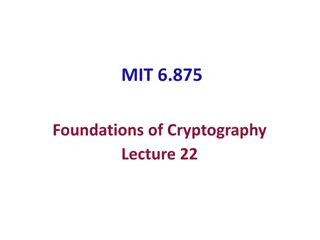
Understanding Electrometallurgy: Processes, Applications, and Principles
Explore the world of electrometallurgy, focusing on the principles, processes, and applications of electrolysis in extracting and refining metals. Discover the significance of electrochemical potentials, Faraday's laws, and the diverse uses of this innovative technology in metallurgical engineering.
Download Presentation

Please find below an Image/Link to download the presentation.
The content on the website is provided AS IS for your information and personal use only. It may not be sold, licensed, or shared on other websites without obtaining consent from the author. If you encounter any issues during the download, it is possible that the publisher has removed the file from their server.
You are allowed to download the files provided on this website for personal or commercial use, subject to the condition that they are used lawfully. All files are the property of their respective owners.
The content on the website is provided AS IS for your information and personal use only. It may not be sold, licensed, or shared on other websites without obtaining consent from the author.
E N D
Presentation Transcript
Metallurgical engineering MET4331 3 credits Ph.D, Assistant Professor Mamyrbayeva Kulzira Kaldybekovna
Lecture 10. Electrometallurgy Today s subtopics: The principle of electrometallurgical processes Electrolysis Standard electrode potentials row of electrochemical potentials Dissociation pressure Faraday s laws
Elecrometallurgy Electrometallurgy deals with the conversion of metallic salts, oxides or sulfides into metals (electrowinning) or with purification of the metals (electrorefining) by electrolytic processes, i.e. processes where the chemical energy required by the chemical reactions is supplied by electrical energy, involving passage of an electric current through an electrolyte that conducts current between two electrodes Nowadays some metals are produced exclusively by electrolysis, whereas in the case of some others, a substantial percentage of the total production is by electrowinning. The approximate percentages (by electrolysis) of some important metals are: aluminium 100; sodium 100; lithium 100; magnesium 80; chromium 70; cobalt 50; cadmium 50; zinc 50; copper 10; nickel 10. Electrolysis can be used, among other methods, to obtain other metals, for example, Be, , Nb, rare earths, Ga, Ti, TI, In, Zr, Hf, and B. The electrometallurgical processes can be categorized into four main groups: 1. Electrowinning, the extraction of metal from ores. 2. Electrorefining, the purification of metals. Metal powder production by electrodeposition is included in this category, or sometimes electrowinning, or a separate category depending on application. 3. Electroplating, the deposition of a layer of one metal on another. 4. Electroforming, the manufacture of, usually thin, metal parts through electroplating.
The principle of electrometallurgical processes The principle of electrometallurgical processes is a passage of electrical current through dissociated solutions (electrolytes) accompanied by oxidation and reduction processes on the electrodes. Electrometallurgy is used for production of metals from: PLS of ores smelts metallurgical semi-products metallurgical wastes Electrochemical methods together with hydrometallurgy enable economical processing of low-concentrated complex ores and usage of all components of an original raw material.
Electrolysis Electrolysis is a chemical process, during which chemical conversions in an electrolytic solution occur due to the effect of direct current supplied from an external source. A device, in which electrolysis proceeds, is called an electrolytic cell. A substantial part of an electrolytic cell consists of a vessel with a solution or smelt of an appropriate electrolyte. Direct current is supplied to the solution from a suitable source using electrodes. The electrode connected to the negative pole of a source, on which is always redundancy of electrons, is denoted cathode. The second electrode, connected to the positive pole, featuring lack of electrons, is denoted anode. Current conduction in an electrolyte is enabled by free movements of ions. When a cell is circuited, positively charged ions (cations) move to a cathode, while negatively charged ions (anions) move to an anode. Contacts of ions with electrodes result in an occurrence of oxidizing and reducing processes. The cathode transfers its redundant electrons to ions and reduces them, while the anode removes electrons from ions and oxidizes them. These phenomena are denoted as cathodic reduction and anodic oxidation (Fig. 1).
Standard electrode potentials row of electrochemical potentials After an immersion of a metal into a solution of its salts, the metal starts to dissolve and generate ions, which generates a certain dissolving pressure. Against this pressure affects the pressure of surrounding ions in the solution, the osmotic pressure. After equalization of these pressures, equilibrium in a close vicinity of an electrode is established and a thin electric bi-layer generating a difference between the electrode and electrolyte potentials electromotive force is produced. The value of the force is different for different metals. A potential of such a half-cell cannot be measured, therefore two half-cells are usually connected and a difference between their potentials is then measured. A standard hydrogen electrode with the potential of 0.0 V was established to be the basic comparative half-cell. The charge of the standard potential is then obtained according to the relation of a given electrode to the hydrogen electrode. Example: Cu2+/ Cu is a positive pole in a cell if aH+ = aCu2+= 1 is ECu2+ / Cu = + 0,34 V Zn2+/ Zn is a negative pole in a cell if aH+ = aZn2+ = 1 is EZn2+/ Zn = - 0,76 V
Standard potentials characterize reducing or oxidizing abilities of particles in aqueous solutions. The more negative is the standard potential, the stronger is the reducing agent (Fig. 2). Metals located at the bottom end of the row of electrochemical potentials (alkali and alkaline earth metals) represent very strong reducing agents and are easily oxidizable. Metals with negative standard potentials are denoted non-noble metals, metals with positive standard potentials are denoted noble metals. Fig. 2 Row of metals according to standard electrode potential values (according to the theoretical nobility).
Description of basic terms 1. Electrochemical potential Substitution of charges, possibly electrons, between two materials is given by their electrochemical potentials. The tendency of a metal to convert to a solution of its salts is given by the Nernst equation: The standard electrode potential of a hydrogen electrode, used as a primary standard for pH measurements, is equal to:
2 Dissociation pressure To perform electrolysis of a given electrolyte, it is necessary to supply the electrodes with a sufficiently high voltage. The minimum voltage necessary to ensure passage of electric current through a solution is denoted electrolyte dissociation pressure. Its value is given by the relation: Ur = Up + IzR where Up polarization voltage; Iz cut-off current; R resistance of electrolyte. The polarization voltage is equal to a difference between the polarization potentials of anode and cathode. Up = Epa Epk The potential of a polarized electrode is Ep = E + , where is overvoltage. Then the dissociation pressure is given as: Ur = (Ea +a) (Ek +k)
3 Polarization Dissociation of a solution by an electric current results in a generation of a new cell by the occurring chemical reactions on the electrodes. The electromotive force of this cell affects against the electromotive force supplied from an external source. This is the polarization voltage. 1. Concentration polarization is a certain type of polarization which occurs during refining electrolysis due to the changes in concentrations of ions in the vicinities of electrodes. The concentration of ions increases around a dissoluble anode, while it decreases around a cathode. The generated concentration gradient, which is directly proportional to the intensity of electric current, can lead to a decrease in the rate of electrolysis. Therefore, its elimination by an intensive agitation of the electrolytic bath enforced circulation using centrifugal pumps, mechanically or by flow of air bubbles is necessary. 2. Chemical polarization is a result of generation of gasses and chemical compounds on the electrodes. It increases consumption of electrical energy. Therefore it is necessary to reduce its influence by an addition of a depolarizer into the electrolyte. Depolarizers are substances reacting with the produced chemical combustion gasses and therefore prevent chemical polarization.
Faradays laws 1 Faraday s law The mass of a substance altered at an electrode during electrolysis is directly proportional to the quantity of electricity transferred at that electrode. Quantity of electricity refers to electrical charge, typically measured in coulombs, and not to electrical current. m = q I t m - the mass of the substance altered at an electrode (g); q I current (A); t - time (s). 2 Faraday s law For a given quantity of electricity (electric charge), the mass of an elemental material altered at an electrode is directly proportional to the element's equivalent weight. The equivalent weight of a substance is its molar mass divided by an integer that depends on the reaction undergone by the material. Q = nzF = It Q - the total electric charge passed through the substance; F = 96 485 C mol-1 is the Faraday constant; M - the molar mass of the substance; z - the valence number of ions of the substance (electrons transferred per ion).
Selection of a proper electrolyte In electrolytic operations, the selection of a proper electrolyte is the most important requirement. The basic conditions that an electrolyte must satisfy are: it must have a sufficiently high ionic conductivity, and conduction must be 1. entirely due ions. 2. the electrolysis products. it must be chemically inert towards the electrodes, the container material, and 3. it must be stable at the temperature of operation. 4. must be chemically more stable than the solute. when a solution containing the metal to be extracted is being used, then it Common metals such as Cu, Zn, Sn, Au, and Mn can be produced by aqueous electrolysis, whereas reactive metals such as Ti, Zr, Th, Na, K, Mg, and Al cannot. To obtain reactive metals, their fused salts must be electrolyzed at a high temperature.
Effect of additives Many substances, usually organic ones, significantly influence deposit characteristics. Being adsorbed on the surface of the growing crystals, they inhibit crystal growth, making the continuous formation of new crystalline nuclei easier, thus leading to polycrystalline deposits. Increasingly fine deposits that are microcrystalline and smooth are obtained for increasing deposition rates and increasing additive contents.
Answer to the following questions: 1) What is the principle of electrometallurgical processes ? 2) Which metal is extracted by Electrometallurgical method? 3) What is Electrolysis? 4) What is Polarization? 5) Explain of Faraday s laws






















